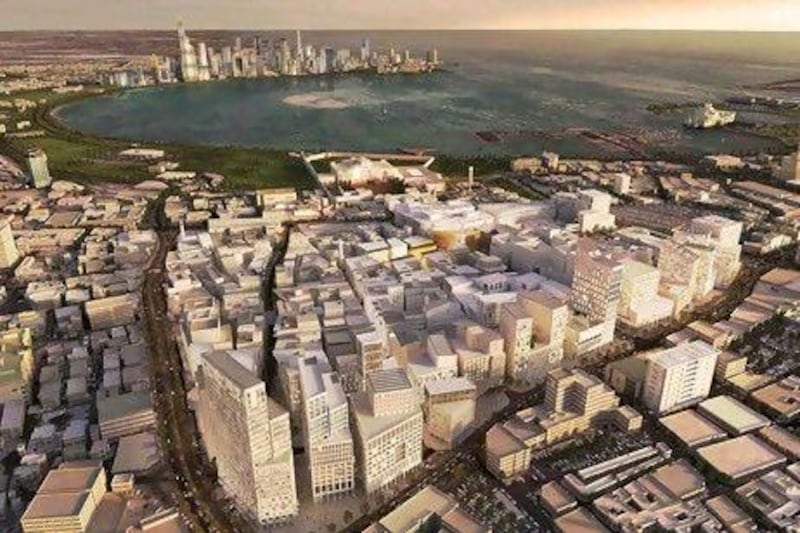In the middle of old Doha there is a huge building site the size of 30 football pitches.
Standing amid the dust, scaffolding and building structures is a traditional house that dates back to the early part of the last century.
About 100 years old and considered a heritage site, it is one of a handful of buildings to be saved as a 31-hectare area around them is completely regenerated.
"At one point the house was just standing floors above everything else," says Rikk Calandros, the logistics manager for Time Qatar, the project manager for Msheireb Downtown, one of Qatar's major construction projects.
The whole Msheireb project dug out up to five floors deep, for car parks, around the old house, which at one point seemed to be standing on a pillar, as a majestic symbol of the past. Commercial offices, residential buildings, hotels, shops, a museum, government institutes and a school are some of the buildings slated to crop up around the old house, all being built to sustainable and green standards.
"The example we are making is going to change and make a transformational thinking towards identity and things rooted in our past, things that respect the local norms," says Issa Al Mohannadi, the chief executive of Msheireb Properties, the project's developer.
About 100 buildings will eventually be built to a souq design in Msheireb Downtown, most to Leadership in Energy and Environmental Design (Leed) Gold standards. Leed is a rating of a building's sustainability and green credentials.
One of the major green selling points is the whole site has been designed to be self-coooling, encouraging people to walk around the area, even in the stiflingly hot summer months. The north side features smaller, open buildings that let in the wind off the sea, the breeze is then expected to funnel through the narrow streets of the downtown area, providing respite from the heat.
Moving from the north side to the south, the buildings become progressively taller, each shading the one before it from the sun's rays.
With buildings ranging from three floors to 30, the whole project is relatively low-rise compared with other parts of Doha's growing skyline.
"All of this is to end up with something we are proud of as a nation," Mr Al Mohannadi says. "Let's change the mindset of 'Let's build the tallest, the biggest, the fastest.' "This is not that kind of thinking, it's supposed to be an example of what modern cities in Qatar and the whole region should look like."
Masdar City, Abu Dhabi's flagship green project, is of a similar ilk to Msheireb, planning to house 40,000 residents and host hundreds of businesses. "We have seen Masdar, which will look something similar when they push on with the development, says Matthew Green, the head of consulting at the property consultancy CB Richard Ellis in Dubai. "You are going to see more and more of these environmental and sustainable developments."
But the Masdar development is slightly different to Msheireb because it is not a regeneration project of a downtown area. It is still in the build phase, with retail, residential and commercial space expected to be completed in 2015.
"Regeneration has not been done in the region," Mr Al Mohannadi says. "It has a different set of challenges than developing a project outside the city. You have to deal with infrastructure, you have to deal with existing buildings, you have to relocate, deal with the city infrastructure and ensure you are not disrupting any services to other parts of the city." In total, the Msheireb Downtown is expected to cost US$5.5 billion (Dh20.2bn) and to be completed in 2016. It is being built in four phases, with the first slated to be finished by the end of the year.
This phase is due to include an extension of the palace of the emir, Sheikh Hamad bin Khalifa Al Thani, a building to hold the emir's guard and the national archive, as well as a heritage quarter that includes a Eid prayer site and four heritage houses.
Part B of the first phase is designed to also include a Mandarin Oriental hotel with 158 rooms and 91 service apartments, two office buildings with 52 retail units and 12 residential buildings providing a total of 180 apartments.
There is expected to eventually be four hotels, a small mall, high-end shopping boutiques, supermarkets and restaurants. "It's the first time we have seen a regeneration project of such size in the region," Mr Green says. "Abu Dhabi will see similar regeneration developments in the next few years but whether on this scale, I'm not sure." All the Qatar buildings will be leased for periods of at least 10 years, with no plans to sell any properties at the moment.
Msheireb Properties is a fully-owned subsidiary of the Qatar Foundation for Education, Science and Community Development, which was established in 1995 with the goal of converting the country's human resources into an educated and resourceful population.
"The concept is that this is an endowment that will generate continuous revenue to Qatar Foundation," says Mr Al Mohannadi.
twitter: Follow our breaking business news and retweet to your followers. Follow us





